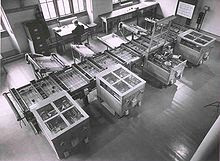Great History Of Computer:
The first use of the word "computer" was recorded in 1613, referring to a person who carried out calculations, or computations, and the word continued to be used in that sense until the middle of the 20th century. From the end of the 19th century onwards though, the word began to take on its more familiar meaning, describing a machine that carries out computations.
Abacus:
The abacus was used for arithmetic tasks. The Roman Abacus was used in Babylonia as early as 2400 BC. Since then, many other forms of reckoning boards or tables have been invented. In a medieval counting house, a checkered cloth would be placed on a table, and markers moved around on it according to certain rules, as an aid to calculating sums of money.
1801: punched card technology
fig:Punched card system of a music machine
In 1801, Joseph-Marie Jacquard developed a loom in which the pattern being woven was controlled by punched cards. The series of cards could be changed without changing the mechanical design of the loom. This was a landmark point in programmability.
In 1833, Charles Babbage moved on from developing his difference engine to developing a more complete design, the analytical engine, which would draw directly on Jacquard's punched cards for its programming. In 1835, Babbage described his analytical engine. It was the plan of a general-purpose programmable computer, employing punch cards for input and a steam engine for power, using the positions of gears and shafts to represent numbers. His initial idea was to use punch-cards to control a machine that could calculate and print logarithmic tables with huge precision (a specific purpose machine). Babbage's idea soon developed into a general-purpose programmable computer, his analytical engine. While his design was sound and the plans were probably correct, or at least debuggable, the project was slowed by various problems. Babbage was a difficult man to work with and argued with anyone who didn't respect his ideas. All the parts for his machine had to be made by hand. Small errors in each item can sometimes sum up to large discrepancies in a machine with thousands of parts, which required these parts to be much better than the usual tolerances needed at the time.
Desktop calculators
fig:The Curta calculator can also do multiplication and division
Companies like Friden, Marchant Calculator and Monroe made desktop mechanical calculators from the 1930s that could add, subtract, multiply and divide. During the Manhattan project, future Nobel laureate Richard Feynman was the supervisor of the roomful of human computers, many of them female mathematicians, who understood the use of differential equations which were being solved for the war effort.
In 1948, the Curta was introduced. This was a small, portable, mechanical calculator that was about the size of a pepper grinder. Over time, during the 1950s and 1960s a variety of different brands of mechanical calculators appeared on the market. The first all-electronic desktop calculator was the British ANITA Mk.VII, which used a Nixie tube display and 177 subminiature thyratron tubes. In June 1963, Friden introduced the four-function EC-130. It had an all-transistor design, 13-digit capacity on a 5-inch (130 mm) CRT, and introduced Reverse Polish notation (RPN) to the calculator market at a price of $2200. The EC-132 model added square root and reciprocal functions. In 1965, Wang Laboratories produced the LOCI-2, a 10-digit transistorized desktop calculator that used a Nixie tube display and could compute logarithms
Then
Advanced analog computers
Digital computation
ENIAC
.fig: ENIAC performed ballistics trajectory calculations with 160 kW of power
For more infrrmation visit
http://en.wikipedia.org/wiki/Computer_history





















0 komentar:
Post a Comment